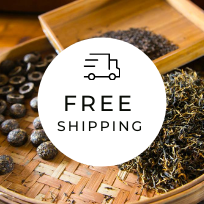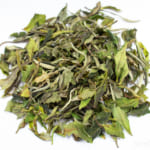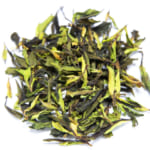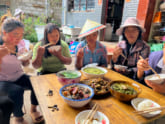- HOME >
- New Arrival at HOJO Online Shop
2016 Ma An Shan Raw Pu-erh Tea Mao-Cha Pre-Booking
- [2016.04.18] Posted By Akira Hojo

We purchased Ma An Shan Raw Pu-erh Tea. Tea became excellent quality this year because there was no rain one week before plucking season. Since we are very happy with the quality, we decided to open the pre-booking of the Ma An Shan mao cha (loose tea).
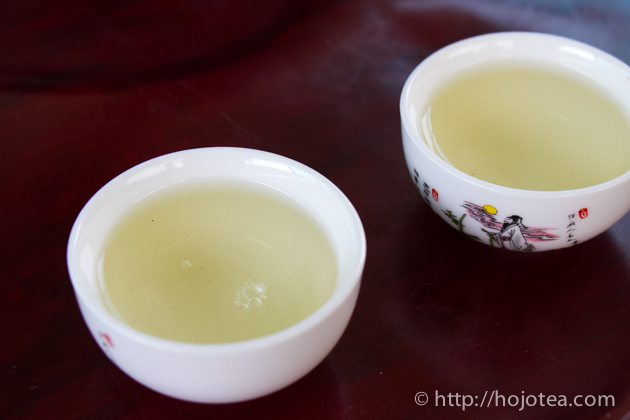
Ma An Shan tea gives extraordinarily strong body
Ma An Shan is a very famous tea production area in Zhen Kang county, Yunnan Province.
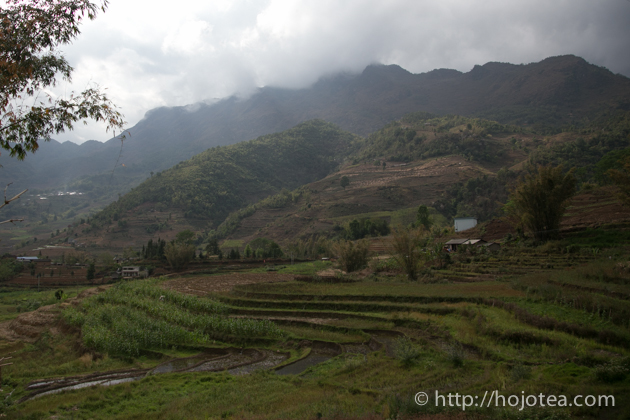
Ma An Shan tea gives a bold taste and three dimensional sensation on palate that makes us feel very rich and broad drinking feeling. In fact, any agricultural product in Ma An Shan, such as coffee, rice and vegetable, gives the same taste profile. It is due to the yellow and elastic soil in Ma An Shan. The characteristic of the soil in Ma An Shan is like the fine Zhu-ni (朱泥). The taste profile of Ma An Shan tea is similar to the famous tea origin such as Lao Ban Zhang (老班章), Yi Wu (易武) and Xi Gui (昔归). Tea from these places all gives very strong body, that makes flavor very rich and broad. I personally feel that the taste of Ma An Shan tea is one of the strongest among the tea from these famous tea production areas. Nevertheless, the price of Ma An Shan tea is 1/10 of these famous places due to the very remote location and less people are visiting there.



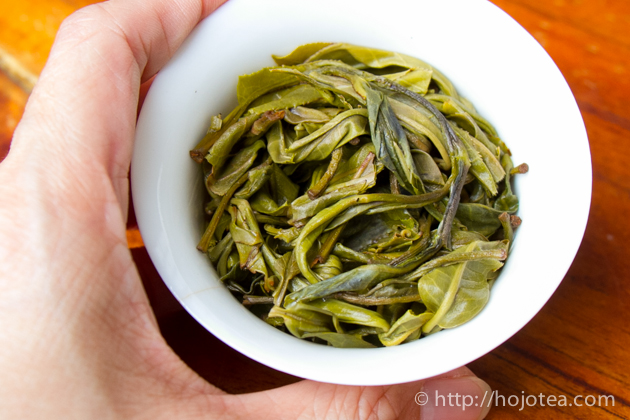
We only select tea from the natural farming garden (with no fertilizer)
Although Ma An Shan is still less known in the world, its name is very famous in local county like in Zhen Kang and Yong De. Recently, the agricultural practice in Ma An shan village has change a lot. Ever since the price of tea increases, farmers use fertilizers in order to increase the output of tea. Usually once the fertilizer is applied, tea grows faster. As a result, the aftertaste of tea becomes very light, thin and less complexity. Nevertheless, although the fertilizer is applied, the Ma An Shan tea still gives very strong body. It could be due to the fact that the soil in Ma An Shan is overwhelmingly good quality. However, the quality of tea is not just about the aftertaste and body. Once the fertilizer is used, the taste of tea is no longer very clean and clear, but it taste becomes bitter and coarse. Whether tea is grown with fertilizer or not gives a very noticeable outcome, even those who are less familiar with tea could tell the difference when they drink and compare the taste side by side. Since we love the taste of naturally-grown tea, we source our pu-erh tea from the remote tea garden located at much higher altitude than the Ma An Shan village. Since the particular tea garden is too far away from any village, no one is willing to take the trouble to carry the fertilizer in such a long way up to the tea garden. As a result, tea trees are kept in very natural environment.

Muscatel Flavor
The naturally grown Ma An Shan tea gives a very sweet muscatel flavor if tealeaf is processed into white tea or black tea. The muscatel flavor comes from the specific constituents in tealeaf. These tea constituents are developed in responding to the attack of insects on tealeaf. Since no weeds are removed and no pesticide are applied, the tea tree in this Ma An Shan area is exposed to attack of these insects. It is just like the tealeaf used in making Oriental Beauty in Taiwan. The tea garden is left without removing weeds and no pesticide is used. The natural environment promotes a balanced ecology. Only the natural farming garden is possible to have the presence of insects. It may sounds unfavorable to the tea manufacturer because of the output could be reduced; nevertheless, the tea quality and characteristic is beyond ordinary tea garden.

In last year, we introduced Ma An Shan white tea produced from natural farming garden. After keeping the white tea for a year in Malaysia, tea develops a very sweet muscatel flavor. Since the same tealeaf is used for raw pu-er tea, I am very excited to see the outcome after aging it for a few years. The tealeaf of Ma An Shan is slightly bigger than the tealeaf from other origin. As oppose to its appearance, the taste of Ma An Shan raw pu-erh tea is very soft and sweet. With good water, it brings up the flavor that reminds me of mango. In fact, I was very impressed by the mango flavor when I first tried it.
As we mentioned earlier, this year the quality of Ma An Shan raw pu-erh tea is excellent thanks to the dry weather lasted for a week before tea plucking. In addition, the cold weather slows down the growing speed of tea. As a result, tea tastes very creamy and soft. Tea is also very well-managed in production. Thanks to the perfect management in pan-frying and sunshine drying, tea gives a very clear taste with a hint of floral note, and there is no burnt or musty flavor at all.

Aging between cake and mao-cha
The well-processed pu-erh tea undergoes maturation very well regardless of it is compressed or loose. Since we wish to share the refreshing flavor of the freshly-made tea, we decided to introduce Ma An Shan mao-cha (loose tea). This Mao Cha is only available for the pre-booking in this week. The balance quantity of the tea will be compressed into 200g cake. Ma An Shan Raw Pu-erh Tea contains very high mineral content and rich in poly phenols thanks to the natural farming practice, high altitude and special soil condition. This tea can be stored even up to 30 years or more. Nevertheless, I love to drink this tea when it is very fresh. Although the fresh raw pu-erh tea is not giving strong fruity flavor, it taste is very gentle and delicate; I can drink it throughout a day without getting bored.
The advantage of compress tea into a cake is to speed up the maturation process. On the other hand, the maturation speed of mao-cha is slower than the compressed cake. However, the distinctive refreshing flavor of mao-cha does not disappear but to remain throughout the aging process. Thanks to the collaboration between the flavor of maturation and the original sweet flavor of mao-cha, the flavor of matured mao cha becomes very attractive. Even if the maturation of mao-cha takes a longer time, I always look forward its outcome in a long term storage. If you wish to age the tea, please make sure keep tea without opening the bag. Normally, the flavor of tea becomes nicer after opening the bag for a few days.

The pre-booking of Ma An Shan mao cha is opens until next Monday, 25th of April. The balance quantity of Ma An Shan raw pu-erh tea will be compressed into 200g cake right after 25th of April.
Please do contact our shop and send us e-mail if you wish to book these mao-cha.
Ma An Shan Raw Pu-erh Tea 2016 Mao-Cha/Loose tea
100g (100g bag ) RM158
300g (100g bag x 3) RM450
If you purchase 5 bags, you will get one more bag free.
Related Articles
How to get the latest update on HOJO Tea?
1. Follow Twitter, 2. Click "Like" on Facebook, and 3. Subscribe in newsletter. You can have the latest tea news from HOJO Tea.
 Subscribe the Newsletter to enjoy the privileges
Subscribe the Newsletter to enjoy the privileges- You may receive a free sample upon purchase, or you may have the priority to purchase special products. So please remember to subscribe our newsletter as well as the social network.
- Yunnan Chun Jian Green Tea from High Mountain Gardens
- Yunnan Chun Jian Green Tea is now available.This tea is made from naturally grown leaves harvested from high mountain gardens at 2100m above sea level. It has a rich, long-lasting lingering aftertaste, comparable to raw Pu-erh tea. Yunnan as a Distinctive Tea Growing Region Over the past 20 years, we have explored a wide range …
- Limited Loose Leaf Release of 2025 Da Xue Shan Wild Raw Pu-erh Tea
- We have released the 2025 loose-leaf version of Da Xue Shan Wild Raw Pu-erh Tea.This tea comes from wild tea trees that grow naturally in the high mountains of Yunnan Province, at elevations above 2000 meters. This year, we were only able to secure a small quantity for retail, and the current release is available …
NEW ARTICLES
 Yunnan Chun Jian Green Tea from High Mountain Gardens
Yunnan Chun Jian Green Tea from High Mountain Gardens- Yunnan Chun Jian Green Tea is now available.This tea is made from naturally grown leaves harvested from high mountain gardens at 2100m above sea level. It has a rich, long-lasting lingering aftertaste, comparable to raw Pu-erh tea. Yunnan as a Distinctive Tea Growing Region Over the past 20 years, we have explored a wide range …
 Limited Loose Leaf Release of 2025 Da Xue Shan Wild Raw Pu-erh Tea
Limited Loose Leaf Release of 2025 Da Xue Shan Wild Raw Pu-erh Tea- We have released the 2025 loose-leaf version of Da Xue Shan Wild Raw Pu-erh Tea.This tea comes from wild tea trees that grow naturally in the high mountains of Yunnan Province, at elevations above 2000 meters. This year, we were only able to secure a small quantity for retail, and the current release is available …
 2025 Da Xue Shan Wild White Tea Now Available from Yunnan
2025 Da Xue Shan Wild White Tea Now Available from Yunnan- The 2025 harvest of Da Xue Shan Wild White Tea is now available. Crafted from truly wild Camellia taliensis trees growing naturally in the high-altitude forests of Yunnan, this tea offers a purity and character unique to its origin. This year’s unusually dry climate during the withering season was ideal, resulting in a floral and …
 Why Do Some Teas Taste Astringent? Exploring the Causes and Mechanisms of Astringency
Why Do Some Teas Taste Astringent? Exploring the Causes and Mechanisms of Astringency- Tea can range from having no noticeable astringency to possessing a very strong one. What causes this astringency? This article explores the causes and mechanisms behind astringency in tea. Causes of Astringency Astringency arises from the binding of tea components to proteins in the oral cavity, creating a sensation of tightness or dryness. The tongue …
 The Impact of Heat Sources on Tea Flavor
The Impact of Heat Sources on Tea Flavor- It is widely recognized that the material of a kettle plays an important role in shaping the taste of water for brewing tea. Yet, an often overlooked but equally significant factor is the type of heat source used to boil the water. Different heat sources, whether gas, electric, charcoal, or wood fire, can impart distinct …
 New Release of High Mountain White Tea
New Release of High Mountain White Tea- We are pleased to introduce our High Mountain White Tea, sourced from a unique tea garden with two key features: 1. Located at an altitude of 2200-2300m2. Completely wild and untended The ideal natural conditions of this garden result in tea of exceptional quality, offering a pure and gentle, nourishing taste. High Altitude and Wild …
 New Release of Da Xue Shan Wild White Tea 2024
New Release of Da Xue Shan Wild White Tea 2024- We have released the 2024 Da Xue Shan Wild White Tea Loose Leaf. This tea was produced under our direct supervision during our stay in Yunnan Province, ensuring meticulous production management on site. Definition of Wild Tea in Yunnan Province People in Yunnan strongly associate Camellia taliensis with wild tea, regardless of where it is …
 New Release of Wild Pu-erh Jasmine Pearl
New Release of Wild Pu-erh Jasmine Pearl- Out of curiosity, we decided to create a jasmine tea based on Da Xue Shan Wild Raw Tea. This resulted in an exceptionally rare tea, not only in Japan but also in China. Custom Production Network for Jasmine Tea At our store, we source various types of base teas from different regions during the spring. …
 2024 Overview: Our Yunnan White Tea Quality, Process, and Weather Insights
2024 Overview: Our Yunnan White Tea Quality, Process, and Weather Insights- One of the teas we’ve been focusing on in Yunnan Province is white tea. Historically white tea has been produced in both Fujian Province and Yunnan Province for a long time. While white tea from Fujian Province is well-managed during processing, we are dissatisfied with the quality of the raw materials due to the use …
 Yunnan’s Hospitality Culture: Expressed Through Meals
Yunnan’s Hospitality Culture: Expressed Through Meals- In China, as a form of greeting, it’s common to say “你吃饭了吗?” which means “Have you eaten?” However, in Yunnan Province, the phrase “吃饭” is often used in various situations, more like “Eat, eat,” serving as an invitation to share a meal. Yet, with prolonged exposure to Yunnan, one comes to understand that these meal …
Shop Info

Address:Lot No. T-215, 3rd Floor, The Gardens Mall, Mid Valley City, Lingkaran Syed Putra, 59200 Kuala Lumpur
Tel: +603-2287-4537
Business Hour: 10am to 10pm
Category
- New Arrival at HOJO Online Shop
- Featured Articles
- Newsletter
- Types of Tea
- Origin of Tea
- Teapot and Tea Equipment
- Tea Column
- How to enjoy tea
- Tea Processing
- How to choose quality tea
- Tea constituents and functional effect
- Safety of Tea
- Foods
- Tea Business Operation
- Hobby and Outdoor Activity
- Ranking of Tea
- Video
- FAQ
- Media Release
Profile

- AKIRA HOJO
- I invite you to experience my tea selections.I was born in Nagano, Japan. In university, I studied agricultural chemistry, and I have the master degree in food science. I worked in Japanese food industry for 10 years. I involved in R&D, QC and QA. As a factory manager, I implemented ISO9000 series and managed the factory.
- The Art of Tea Magazine
- We posted the article on “The Art of Tea Magazine No.9, the magazine is published in Taiwan. We featured some scientific view about the tetsubin
- New Straits Times
- The Malaysian National Newspaper, New Straits Times featured HOJO Tea on 17-Oct-2007.


